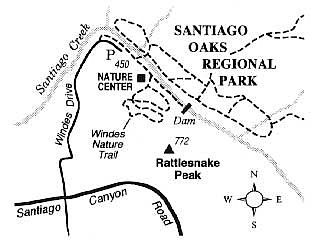 Facebook
Facebook
 X
X
 Instagram
Instagram
 TikTok
TikTok
 Youtube
Youtube
Pint-size Santiago Oaks Regional Park, in the city of Orange, was pieced together from two former ranch properties acquired by Orange County's parks department in the mid-1970s. A small Valencia orange grove and many acres of ornamental trees planted around 1960 on these properties complement the superb natural displays of riparian and oak-woodland vegetation along the area's principal watercourse -- Santiago Creek.
As you approach the park entrance on Windes Drive (off Santiago Canyon Road, east of the 55 Freeway), you leave the monotony of subdivisions behind, and a lush strip of willows and sycamores comes into view on the left. Beyond the parking lot, where a day-use fee is collected, you can stroll up past some oak-shaded picnic sites to the park's superb nature center, housed in a nicely refurbished 70-year-old ranch house.
The park is laced with several miles of trail, the best of which stay close to the wooded bottomlands of Santiago Creek. The self-guiding Windes Nature Trail and its extension, the Pacifica Loop, begins alongside the nature center. Though only about 0.7 mile long, the trail is very steep in places; it meanders up to the northern summit of Rattlesnake Ridge, an isolated, erosion-resistant block of mostly conglomerate rock. On clearer days a slice of Pacific coastline can be glimpsed from the high point of the trail, and a fenced lookout point nearby offers a view almost straight down on Santiago Creek and the rest of the park.
Back down by the nature center, you can walk upstream along the shaded creek bank to reach a small rock-and-cement dam dating from 1892. This dam replaced an earlier one, built in 1879, that was part of one of Orange County's first irrigation systems. Today, the surviving dam is a historical curiosity, dwarfed by the large Villa Park flood-control dam a short distance upstream and Santiago Reservoir farther upstream.
West of the nature center, you can ford Santiago Creek and stroll along several paths amid the eucalyptus, pepper, and other nonnative trees rooted to the gently sloping bench on the creek's far side. Because of the diversity of its natural habitats, Santiago Oaks is a terrific birding spot, with species ranging from the tree-dwelling western bluebird and acorn woodpecker to the water-loving great blue heron. On occasion, vultures and ospreys, as well as some common hawks, can be seen soaring overhead.


Pint-size Santiago Oaks Regional Park, in the city of Orange, was pieced together from two former ranch properties acquired by Orange County's parks department in the mid-1970s. A small Valencia orange grove and many acres of ornamental trees planted around 1960 on these properties complement the superb natural displays of riparian and oak-woodland vegetation along the area's principal watercourse -- Santiago Creek.
As you approach the park entrance on Windes Drive (off Santiago Canyon Road, east of the 55 Freeway), you leave the monotony of subdivisions behind, and a lush strip of willows and sycamores comes into view on the left. Beyond the parking lot, where a day-use fee is collected, you can stroll up past some oak-shaded picnic sites to the park's superb nature center, housed in a nicely refurbished 70-year-old ranch house.
The park is laced with several miles of trail, the best of which stay close to the wooded bottomlands of Santiago Creek. The self-guiding Windes Nature Trail and its extension, the Pacifica Loop, begins alongside the nature center. Though only about 0.7 mile long, the trail is very steep in places; it meanders up to the northern summit of Rattlesnake Ridge, an isolated, erosion-resistant block of mostly conglomerate rock. On clearer days a slice of Pacific coastline can be glimpsed from the high point of the trail, and a fenced lookout point nearby offers a view almost straight down on Santiago Creek and the rest of the park.
Back down by the nature center, you can walk upstream along the shaded creek bank to reach a small rock-and-cement dam dating from 1892. This dam replaced an earlier one, built in 1879, that was part of one of Orange County's first irrigation systems. Today, the surviving dam is a historical curiosity, dwarfed by the large Villa Park flood-control dam a short distance upstream and Santiago Reservoir farther upstream.
West of the nature center, you can ford Santiago Creek and stroll along several paths amid the eucalyptus, pepper, and other nonnative trees rooted to the gently sloping bench on the creek's far side. Because of the diversity of its natural habitats, Santiago Oaks is a terrific birding spot, with species ranging from the tree-dwelling western bluebird and acorn woodpecker to the water-loving great blue heron. On occasion, vultures and ospreys, as well as some common hawks, can be seen soaring overhead.
